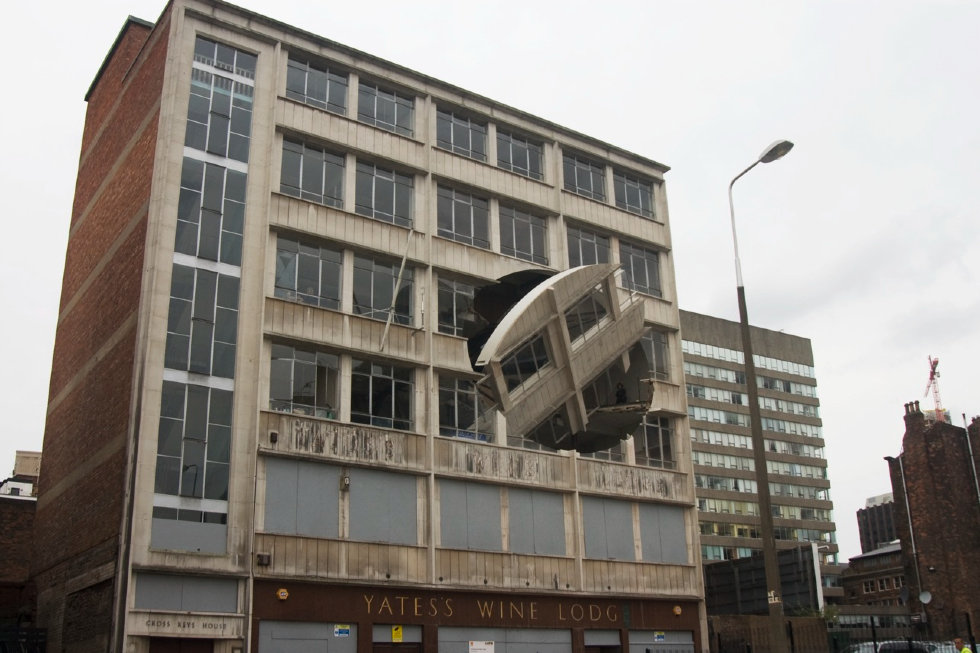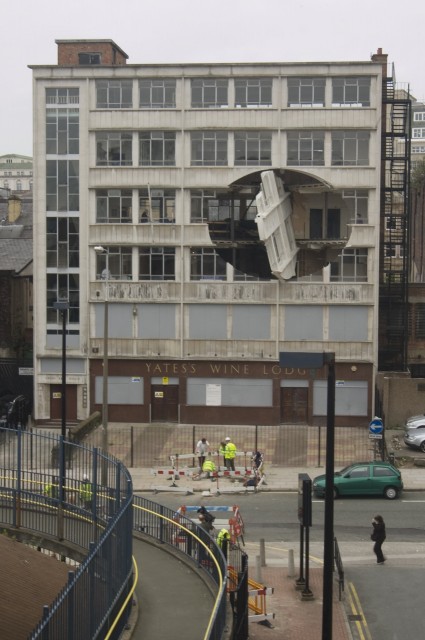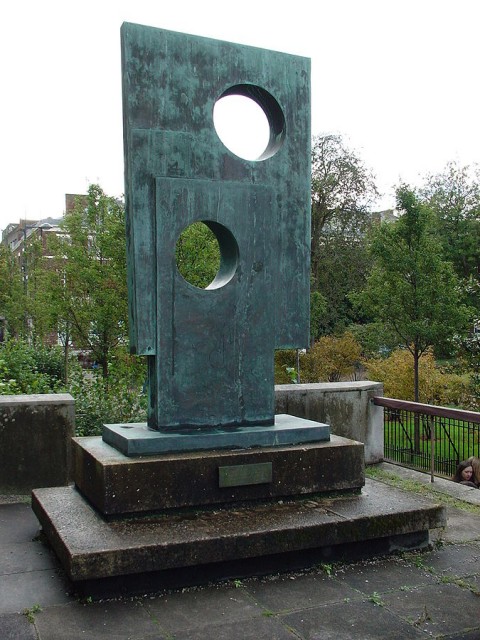Finding Richard and Barbara: A Sculpture Walk

“Perhaps public artworks are created knowing they will be relinquished to external forces: to the elements, to politics, and their publics.” Denise Courcoux on the mixed fates of public sculpture in Liverpool…
In the summer of 2007, jaws dropped and mouths made ‘o’s as people emerged from Moorfields train station to be confronted by a building turning itself inside-out, offering glimpses of its innards while simultaneously disorientating routine-worn commuters. Richard Wilson’s Turning the Place Over was conceived of as a spectacular curtain-raiser for Liverpool’s year as European Capital of Culture 2008. Liverpool Biennial’s website describes it as the ‘jewel in the crown’ of the city’s public art programme, in copy brimming with the confidence abundant in Liverpool’s cultural institutions a decade ago. Wilson’s precision-cut circle, eight metres across, sliced through three of this building’s six storeys, windows and all. It oscillated and inverted itself through 360 degrees, powered by the kind of machinery used in heavy industries such as shipping; a nod to Merseyside’s engineering heritage.
Wilson’s cut-out rotated long after the last fireworks burned for Capital of Culture, a rare example of a public artwork that earned something approaching immediate affection from its audience. It made the final orbit of its spindle in January 2011. The temporary artwork wasn’t meant to last that long, and neither was its host building, Cross Keys House; an unloved and unlovely fifties block, its offices and ground floor pub long abandoned. It was earmarked for demolition, but plans for a new business complex and public square went forebodingly quiet. Perhaps conscious of the irony of Moorfields station (the gateway to Liverpool’s ‘business district’ standing opposite a derelict office block), for a period the council covered the façade with a plaintive banner: ‘Invest in Liverpool. Let’s do business’.
In August 2018, I navigated the peculiar exit to Moorfields; up a steep escalator, and down another, beneath strip-lit plastic to street level. I’d travelled this way as a commuter before, but on this weekend visit, the absence of workers made the place strange. The station’s canopy sheltered a solitary homeless man, but flattened cardboard boxes disclosed more sleeping here. Cross Keys House stood square and grimy beyond the opposite pavement, disconnected on all sides. Gold lettering along the lower tier still spelled YATES’S WINE LODG, the final E a shadow. Wilson’s cut-out circle was clearly visible halfway up, perfectly still and flush now, floating inscrutably in its void. I crossed the road; a woman, lost in the wrong part of town, asked the way to the shops. The building appeared untouched by humans for many years, but it doesn’t take long for nature to take hold.

Thick-stemmed weeds scaled the mesh fencing, buddleia pushing purple fingers closer than I could reach. Washed up at the barrier was a deep line of sun-bleached litter and an abandoned suitcase, spongy and warped. I wondered what it was like inside Cross Keys House; what could penetrate through the gaps of Wilson’s work and the missing window panes? And I wondered how long Turning the Place Over will remain, dormant, and what today’s passers-by make of the hole in the wall.
I walked to the opposite end of town; minutes on a good day, but everything seemed to take longer in the heat. Two hen parties engulfed me, invisible, and spat me out tireder. Saturday in the city has its own particular cast of characters. I walked up, away from the river. Outside the spaceship-like Metropolitan Cathedral, a man sat bent double on a bench, absorbing the effects of a hit next to the tourist coaches. I entered the University of Liverpool’s campus. Like the business district, it’s a place that feels incongruous when the activity has dispersed. During end-of-term holidays, students and staff departed, rumbling reverberations of skateboard wheels bounced around the closed inner courtyards of the teaching blocks; I couldn’t tell how the skaters had got in.

The semi-public realm of the university is home to a number of artworks; sculptures by Hubert Dalwood, Elisabeth Frink, Phillip King and more pepper the campus, a portrait of the twentieth century ideal of incorporating art into urban planning. If the University of Liverpool has a jewel in its public art crown, it is its Hepworth. Square with Two Circles (1964) has formal echoes of Cross Keys House: two modernist monoliths, with circular cavities, and both in increasingly peculiar environments. Cast in bronze, this sculpture departs from the curved, organic shapes Hepworth is best known for. It is bold and angular; an unapologetic presence, yet human in proportion.
I used to live at this end of town, and remember its old home alongside the formal gardens of Abercromby Square. I went back to the site, and the scale of the platform it used to occupy still struck me with awe. It was designed by Hepworth, and eventually approved following wrangling over cost versus artistic integrity. A concrete altar, unfolding out low from the adjoining Senate House in flat tiers, its lower level is a broad, empty plain; a space from which to contemplate. Steps lead up to where the sculpture used to stand with the sky visible through its apertures. I stood in its place, noticing the plinth’s missing corner, the dark moss that clung to the edges, cigarette ends in the cracks.
In 2015, Square with Two Circles was moved. A member of university staff suggested it had been relocated to a place of higher footfall. An old tweet unearthed states that the platform had become unsafe. A guided walk I went on a couple of years ago – playing the tourist in my own territory – proposed it was the result of new student apartments; the planning application required public art, and the Hepworth was moved in lieu of a new commission. I am not sure where the truth lies. I walked to its new home, five minutes away. The sculpture now sits at ground level in an angular patch of grass, made straw by the summer’s heatwave. Its painterly surface, streaked with green patina, displays the weathering of half a century outdoors. At the base is the artist’s looping script: ‘Barbara Hepworth 1964 0/3’. Six slim blocks border it; the same as the kerbstones which separate the grass from paving, the opposite of bespoke. Four had fallen over, exposing thick rods anchoring the sculpture to the ground, and a paper cup blown or wedged inside. I touched the cool bronze, and looked through one of the Two Circles at Crown Place, its shiny orange cladding set with tiny square windows; rooms soon to be occupied by new students. Perhaps public artworks are created knowing they will be relinquished to external forces: to the elements, to politics, and their publics.
Denise Courcoux
Our next Liverpool Sculpture Walk is happening on Sunday 27 November 2022, book now!
This essay was originally published in Present Tense: A Decade Since Liverpool Capital of Culture… What Now? (buy a copy here). All information was correct at time of writing.
Image credits from top: Turning the Place Over, Richard Wilson, 2007, courtesy Liverpool Biennial. All photographs by Alexandra Wolkowicz; Square with Two Circles, Barbara Hepworth, 1964 (pictured outside Senate House, University of Liverpool).





